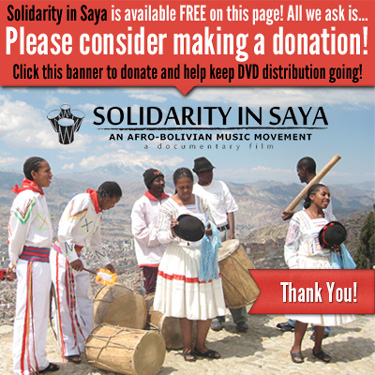
About the film
Solidarity in Saya presents the inspiring and little known story of the history and experience of the Afro-Bolivian community that has used its traditional Saya music and dance as a form of resistance and empowerment. Although their ancestors were enslaved and brought by Spanish colonizers to the region that would become Bolivia, even today many people in the world are unaware of the existence of the Afro-Bolivian community. In this rare exploration of the culture of the Afro-Bolivian community, viewers meet Afro-Bolivians in rural and urban settings, from youth to elders, and hear stories of the realities of their daily lives.
This captivating, rhythmic, and musical film is woven together with a soundtrack and scenes of live Saya music, historical narration, and the voices of Afro-Bolivians, bringing to light the story of the resilience of this community and the strength of their culture and their continued effort in the struggle for equal rights and visibility in Bolivia and around the world.

About the Afro-Bolivian community and Saya Music
Although it is not widely recognized that Bolivia has a community of African descendants, Spanish colonists brought enslaved Africans to Potosi to work in the silver mines and to surrounding areas for agricultural and domestic labor. Since this region has such an extreme landscape, many enslaved African people died en route from the ports making them prohibitively expensive for many, hence why there were not as many African people as in other colonial regions.
Currently the largest community of Afro-Bolivians lives in the semi-tropical region of the Yungas in the department of La Paz. For centuries after the abolition of slavery, Afro-Bolivians continued living in isolated rural villages under the hacienda system, then as independent subsistence farmers after the agrarian revolution in 1952.
Beginning in the late 1980s, there was a wave of urban migration of Afro-Bolivians, first to La Paz, then increasingly to Cochabamba and Santa Cruz. Many faced alienation and discrimination in their new urban environment in a country that was hardly aware of their culture’s existence. In 1988 in La Paz, a small group of Afro-Bolivian youths began organizing gatherings to play their traditional Saya music to build community in opposition to marginalization in mainstream Bolivian society. The Saya group met and performed in public spaces and this was often the first time even other Bolivians began to recognize the presence of people of African descent in their country.
Saya music was a way for people in the Afro-Bolivian community to come together, build solidarity, and demand to be seen by claiming space physically with their collective presence. Rather than standing idle while the colonial hegemonic system of racial hierarchy defined them, the Afro-Bolivian Saya group members empowered themselves by defining their own identity through these music performances. Through song lyrics, they could tell their own stories, teach people about their history and demand that the public hear their voices.
The Saya music groups picked up momentum and began performing in venues such as nightclubs and gained entry into the national traditional folkloric parades, such as Carnaval. Through Saya performances, the Afro-Bolivian community continued to increase their visibility nationally and internationally through varied audiences and media coverage.
The social cohesion and unity cultivated within the Saya group became a platform for political activism to confront the invisibility of the Afro-Bolivian minority. Saya music is not only a vibrant celebration of Afro-Bolivian culture but also a powerful tool in gaining recognition, spreading awareness, and continues to be a space where political goals and messages can reach the public. What began as gatherings of informal music groups has gone far beyond just Saya music and has grown into a movement with many incredible social and political achievements.


